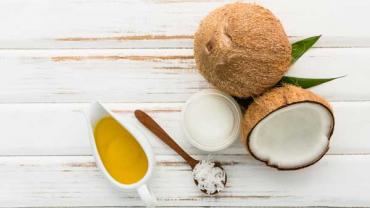
It’s interesting to walk into conventional supermarkets and health food stores alike and see multiple options for coconut oil readily available on the shelves. It wasn’t all that long ago that coconut oil was a rarity in North American stores. After all, conventional nutrition held fast to the belief that saturated fat was harmful for health, and since coconut oil consists of as much as 92% saturated fat, who in their right mind would have sought out a whole jar of it? The tide has definitely turned on that misguided premise and there’s been an avalanche of research uncovering beneficial roles for the medium-chain fatty acids (often called medium chain triglycerides, or MCTs) in this once-demonized oil. (Previous articles have covered potential beneficial roles for MCTs in amyotrophic lateral sclerosis and improving cognitive function.) A particular derivative of lauric acid, one of the MCTs in coconut oil, may be especially helpful in fighting pathogenic bacteria and fungi. It’s been over two years since we last explored this compound, monolaurin, so let’s take a look at research that’s come out since then and get an update.
As a quick refresher, monolaurin, also called glycerol monolaurate, is a mono-ester consisting of one molecule of lauric acid bound to glycerol. Lauric acid itself is virucidal and bactericidal but these activities are greater in monolaurin. Humans metabolize small amounts of monolaurin from lauric acid but the amount is believed to be low, so as an intervention, monolaurin is required in higher amounts than would be obtained from a reasonable intake of coconut oil. (Other sources of lauric acid include palm kernel oil, goat milk, and human breast milk. Coconut and palm kernel oils both contain approximately 48% lauric acid. Watermelon seeds and macadamia nuts also contain lauric acid but in miniscule amounts.)
Monolaurin is effective against an impressive array of bacteria, viruses, fungi, protozoa, and parasites. Perhaps most encouraging, however, is that monolaurin has not been shown to result in antibacterial resistance nor to have adverse effects on beneficial intestinal flora. For these reasons, in addition to acute targeted use, it may also be used as a potential preventive measure during cold and flu season or taken on an ongoing basis by individuals susceptible to recurrent infection and illness. Monolaurin may be a good thing to have on hand during the long, cold, dark days of winter.
Research published last month in the journal Molecules reinforced the established findings that monolaurin is effective against both gram-positive (G+) and gram-negative (G−) bacteria, although it appears to be more powerful against G+ organisms. (The minimum inhibitory concentration [MIC] value of monolaurin ranged from 10 to 500 mg/L against G+ bacteria and from 600 to 10,000 mg/L against G− bacteria.) Monolaurin exhibited antibacterial activity against Streptococcus pneumoniae, Enterococcus faecalis, and Campylobacter jejuni. The latter, C. jejuni, is one of the most common causes of food poisoning and the most frequently diagnosed bacterial cause of human gastroenteritis in the US. Monolaurin was effective against Staphylococcus, Streptococcus, Bacillus and several other G+ organisms with relatively low MICs.
It’s believed that monolaurin and other fatty acid derivatives with antimicrobial properties exhibit their effects by disrupting bacterial cell membranes, causing subsequent cellular disorganization. Research indicates that the ability of medium chain fatty acids to disrupt cell membranes varies among different bacterial strains, which may explain why monolaurin is more potent against G+ strains. According to the paper in Molecules:
“G+ bacteria have cell walls composed of thick layers of peptidoglycan, whereas G− bacteria have a thin layer of peptidoglycan and an outer membrane that is primarily composed of lipopolysaccharides and proteins. The O-side chains of lipopolysaccharides comprise an effective barrier for hydrophilic molecules, such as lipids. In addition, these lipopolysaccharides are strongly connected, which makes it difficult for molecules to penetrate the outer membranes. This could be the reason that G− bacteria were less susceptible to monolaurin than G+ bacteria in the present study. The outer membrane of Campylobacter species expresses lipooligosaccharides that lack the O-side chain; therefore, they are also more susceptible to monolaurin compared with E. coli and S. Typhimurium.” (Campylobacter is G−.)
We previously described that monolaurin is also affective for disrupting bacterial biofilms. An in vitro study from May 2019 showed that monolaurin nanocapsules significantly reduced biomass, proteins, polysaccharide and viable organisms of Pseudomonas aeruginosa, a frequent cause of hospital-acquired infections as well as respiratory tract infections in individuals with cystic fibrosis.
There may even be a role for monolaurin in tackling the problem of antibiotic resistance in food production. Monolaurin added to the feed of broiler chickens reduced bacterial counts and oocyte number from Eimeria spp, a common cause of parasitic infection in chickens, and which may also cause infections in cattle, sheep and goats. The researchers concluded that monolaurin may be “a promising alternative to replace conventional antimicrobials used in the diets of broiler chickens.” Perhaps it would be effective in other animals as well. If so, a gradual shift toward this more natural approach could potentially benefit humans as well, if fewer antibiotics are used in food production. This remains speculative for the time being, however.
Individuals who enjoy coconut oil can consume it without fear that its saturated fat is harmful for cardiovascular health. But when something more potent is needed to help support the body’s natural defenses, reach for monolaurin.